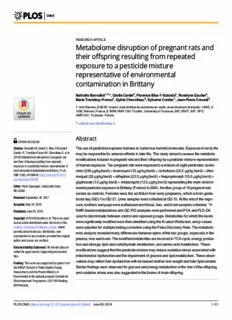
Metabolome disruption of pregnant rats and their offspring resulting from repeated exposure to a PDF
Preview Metabolome disruption of pregnant rats and their offspring resulting from repeated exposure to a
RESEARCHARTICLE Metabolome disruption of pregnant rats and their offspring resulting from repeated exposure to a pesticide mixture representative of environmental contamination in Brittany NathalieBonvallot1,2*,Ce´cileCanlet2,FlorenceBlas-Y-Estrada2,RoselyneGautier2, a1111111111 MarieTremblay-Franco2,SylvieChevolleau2,SylvaineCordier1,Jean-PierreCravedi2 a1111111111 a1111111111 1 UnivRennes,EHESP,Inserm,Irset(Institutderechercheensante´,environnementettravail)—UMR_S 1085,Rennes,France,2 INRAUMR1331Toxalim,UniversityofToulouse,INP,ENVT,EIP,UPS, a1111111111 UMR1331,Toulouse,France a1111111111 *[email protected] Abstract OPENACCESS Citation:BonvallotN,CanletC,Blas-Y-EstradaF, Theuseofpesticidesexposeshumanstonumerousharmfulmolecules.Exposureinearly-life GautierR,Tremblay-FrancoM,ChevolleauS,etal. mayberesponsibleforadverseeffectsinlaterlife.Thisstudyaimedtoassessthemetabolic (2018)Metabolomedisruptionofpregnantrats modificationsinducedinpregnantratsandtheiroffspringbyapesticidemixturerepresentative andtheiroffspringresultingfromrepeated exposuretoapesticidemixturerepresentativeof ofhumanexposure.Tenpregnantratswereexposedtoamixtureofeightpesticides:aceto- environmentalcontaminationinBrittany.PLoS chlor(246μg/kgbw/d)+bromoxynil(12μg/kgbw/d)+carbofuran(22.5μg/kgbw/d)+chlor- ONE13(6):e0198448.https://doi.org/10.1371/ mequat(35μg/kgbw/d)+ethephon(22.5μg/kgbw/d)+fenpropimorph(15.5μg/kgbw/d)+ journal.pone.0198448 glyphosate(12μg/kgbw/d)+imidacloprid(12.5μg/kgbw/d)representingthemainenviron- Editor:PieterSpanoghe,UniversiteitGent, mentalpesticideexposureinBrittany(France)in2004.Anothergroupof10pregnantrats BELGIUM servedascontrols.Femaleswerefedadlibitumfromearlypregnancy,whichisfromgesta- Received:September18,2017 tionalday(GD)4toGD21.UrinesampleswerecollectedatGD15.Attheendoftheexpo- Accepted:May18,2018 sure,mothersandpupswereeuthanizedandblood,liver,andbrainsamplescollected.1H Published:June20,2018 NMR-basedmetabolomicsandGC-FIDanalyseswereperformedandPCAandPLS-DA usedtodiscriminatebetweencontrolandexposedgroups.Metabolitesforwhichthelevels Copyright:©2018Bonvallotetal.Thisisanopen accessarticledistributedunderthetermsofthe weresignificantlymodifiedwerethenidentifiedusingtheKruskal-Wallistest,andp-values CreativeCommonsAttributionLicense,which wereadjustedformultipletestingcorrectionusingtheFalseDiscoveryRate.Themetabolo- permitsunrestricteduse,distribution,and micsanalysisrevealedmanydifferencesbetweendamsofthetwogroups,especiallyinthe reproductioninanymedium,providedtheoriginal plasma,liverandbrain.ThemodifiedmetabolitesareinvolvedinTCAcycle,energyproduc- authorandsourcearecredited. tionandstorage,lipidandcarbohydratemetabolism,andamino-acidmetabolism.These DataAvailabilityStatement:Allrelevantdataare modificationssuggestthatthepesticidemixturemayinduceoxidativestressassociatedwith withinthepaperanditsSupportingInformation files. mitochondrialdysfunctionandtheimpairmentofglucoseandlipidmetabolism.Theseobser- vationsmayreflectliverdysfunctionwithincreasedrelativeliverweightandtotallipidcontent. Funding:Thisworkwassupportedbygrantsfrom theEHESP-SchoolofPublicHealth(Young Similarfindingswereobservedforglucoseandenergymetabolismintheliveroftheoffspring, Researchers)andtheFrenchMinistryof andoxidativestresswasalsosuggestedinthebrainsofmaleoffspring. EnvironmentinthenationalprogramGrenellede l’EnvironnementProgrammeLOLF189Funding (EXPiOmark). PLOSONE|https://doi.org/10.1371/journal.pone.0198448 June20,2018 1/21 Metabolomicsandpesticideexposure Competinginterests:Theauthorshavedeclared thatnocompetinginterestsexist. Introduction Pesticidesarecommonlyusedinagriculture.Theirapplicationcanleadtoenvironmentalcon- tamination.Althoughhumanexposureisnotfullyelucidated,numerousstudieshaveshown thatproximitytoareasofagriculturalpesticideusemaybeasourceofpesticideexposure,in additiontodomesticordietarysources[1–5].Exposuretopesticidesishazardoustohuman health,particularlyinoccupationalsituations,inwhichincreasedrisksofcancer,developmen- taldefects,orneurologicproblemshavebeenobserved[6,7].Suchconclusionsaremorediffi- culttodrawforlow-doseenvironmentalexposuretopesticides.However,fetusesandinfants areparticularlysusceptibletotoxicants.Ananalysisofpublishedstudiesshowsthatprenatal exposuretosomepesticidesmayinducemalformations(herbicides)[8–10],affectfetalgrowth (herbicides,organophosphorous)[11–13],orareassociatedtobehavioraldisorders(organo- phosorous,pyrethroids)[14–23]. Metabolomicsisapromisingapproachtostudytheassociationsbetweenenvironmental exposuresandhealtheffects.Overthelastfewyears,manytoxicologicalstudieshavedemon- stratedthatmetabolomicsisapowerfulmethodfordetectingchangesinthemetabolomeof individualsexposedtopesticides.Arecentcomprehensivereviewshowedthatexposuretopes- ticidesmixturesmayinducemetabolicmodificationspotentiallylinkedwithphysiopathological disturbances[24].Endosulfan,atrazine,andchlorpyrifosincombinationcanpotentiallyinduce changesinamino-acidmetabolism,thecitratecycle,theureacycle,andglucosemetabolism throughanoxidativedisturbanceinmice[25,26].Exposuretoorganophosphorusmixtures (chlorpyrifosandcarbaryl,ordichlorvos,dimethoate,acephate,phorate)inducesdisturbances inenergyandlipidmetabolisminrats[27–29].Alteredlipidmetabolismhasalsobeenrecently confirmedforexposuretoorganophosphorus.:hepaticdysfunction,suchasnon-alcoholicfatty liverdisease,hasbeenobservedinratsexposedtodichlorvos+acephate+phorate+dimethoate [30].Energymetabolismhasalsobeenshowntobealteredbyexposuretopyrethroids(deltame- thrin)incombinationwithdichlorvos[31].Toxicologicalstudiesareusuallycarriedoutincon- ditionswhicharenotrepresentativeofhumanexposures,inparticularbecausetheyinvestigate simplemixturesathighdoses.Onlyonestudyhasbeendesignedtoinvestigatethemetabolic effectsofcomplexmixturesofpesticidesatlowerdoses:Mehrietal.investigatedtheeffectin miceofamixtureoflow-doses(calculatedfromtheirrespectiveacceptabledailyintakesdefined bythejointFAO/WHOmeetingonpesticideresiduesandextrapolatedtothemiceonthebasis ofmeanbodyweightvalues)ofsixpesticidesfrequentlyfoundinfruitsandvegetablesgrownin Franceandshowedametabolicsignaturelinkedtooxidativestressandglucoseregulation[32]. Morethan60%ofthesurfaceareainBrittany(France)isdevotedtoagriculturalactivities, with50%devotedtocerealsandcorn.Inthe2000’s,almostalllandinthisregionreceivedat leastfourdifferenttreatmentstocontroltheproliferationofannualgrasses,fungi,andinsects. In2004,acetochlor(chloroacetanilideherbicide),carbofuran(carbamateinsecticide),chlor- mequat(quaternaryammoniumplantgrowthregulator),ethephon(organophosphorusplant growthregulator),fenpropimorph(morpholinefungicide),imidacloprid(neonicotinoid insecticide),glyphosate(glycinederivativeherbicide),andbromoxynil(nitrileherbicide)con- stitutedalmost90%ofthepesticidesusedoncerealsandcorn.Apreviousstudybasedon83 pregnantwomenfromthePELAGIEcohortshowedchangesintheurinarymetabolomeof womenlivingintownswithhighagriculturalcerealactivities[33].Thesechangesarepoten- tiallyrelatedtoenergymetabolism.Theobjectiveofthepresentstudywastoexaminethe effectsinpregnantratsofarealisticpesticidemixturebasedonsubstancesappliedtocropsin Brittanytosupportthesepreviousobservations. PLOSONE|https://doi.org/10.1371/journal.pone.0198448 June20,2018 2/21 Metabolomicsandpesticideexposure Materialandmethods Chemicalsandexposure Methanol(purity(cid:21)99.8)waspurchasedfromMerck(Darmstadt,Germany).Ultrapurewater wasproducedwithaMilli-Qsystem(Millipore,SaintQuentinenYvelines,France)andwas usedforpesticidedissolution.Theeighthigh-purity((cid:21)98%)pesticides(pestanal1analytical standards)acetochlor(CAS34256-82-1,BatchSZB9314XV),bromoxynil(CAS1689-84-5, BatchSZB8021XV),carbofuran(CAS1563-66-2,BatchSZB9064XV),chlormequat(CAS999- 81-5,BatchSZB8248XV),ethephon(CAS16672-87-0,BatchSZBB021XV),fenpropimorph (CAS67564-91-4,BatchSZB9243XV),glyphosate(CAS1071-83-6,BatchSZB9320XV),and imidacloprid(CAS138261-41-3,BatchSZB9112XV),werepurchasedfromFluka,Sigma Aldrich(LesUlis,France).Theywereincorporatedintotheratdiet,atanominaldosecorre- spondingtothesameproportionastheirrespectiveenvironmentalexposurebasedonFrench usein2004(https://www.airbreizh.asso.fr/),toreachatotaldoseof447μg/kgbw/d,whichcor- respondstothesumoftheirrespectiveacceptabledailyintake.Theoreticalandingesteddoses calculatedfromfoodconsumptionduringtheexperimentareshowninTable1. Preparationofthecontaminateddiet Commercialpowdereddietformulatedforgrowth,pregnancy,andlactation(A03,SAFE)was usedforthisstudy.Wefirstincorporatedthepesticidesintoapremixbatch,becauseofthe extremelylowquantitiesaddedtothediet,bythoroughlymixingtherequiredquantityofeach pesticidewith50gpowdereddiet.Briefly,allpesticidesweredissolvedinmethanol(10mL totalvolume),exceptglyphosate,whichwasdissolvedinwater(1mL),andbothalcoholicand aqueoussolutionswereaddedtothediet.Themixturewasthenhomogenizedfor15min usingaVirtis45Blade-typehomogenizer(Gardiner,NewYork).Theresultingmixwaskept for24hatroomtemperaturetoallowthemethanolandwatertoevaporate.Themixwasthen Table1. Ingesteddosesofpesticidesbydams(μg/kgbw/day),calculatedfromatotaldosebasedonthesumoftheacceptabledailyintake(ADI)ofeachpesticide andtheproportiontotheirlevelofenvironmentalexposureinBrittany(France). Pesticide: Theoreticaloral Dietaryintakebasedonfood ADIa(PODbusedforits Proportionofenvironmentalpesticide Name(chemicalclass) dose consumption derivation)inμg/kgbw/day exposureinBrittany(%)c Acetochlor 290 246 3.6(LOAEL:1080) 64.83 (chloroacetanilide) Bromoxynil(nitrile) 14 12.0 10(NOAEL:1000) 3.16 Carbofuran(carbamate) 27 22.5 0.15(LOAEL:30) 6.03 Chlormequat(quaternary 42 35.0 40(NOAEL:4000) 9.33 ammonium) Ethephon(organo- 27 22.5 30(NOAEL:27000) 6.03 phosphorus) Fenpropimorph(morpholine) 18 15.5 3(NOAEL:300) 4.02 Glyphosate(glycine 14 12.0 300(NOAEL:31000) 3.17 derivative) Imidacloprid(neonicotinoid) 15 12.5 60(NOAEL:3700) 3.43 aacceptabledailyintakefromEFSAandAgritox,datafromtheDecisionoftheEuropeanUnion,availableatwww.efsa.europa.euandwww.agritox.anses.fr,respectively; bPOD:pointofdeparture(NOAEL:noobservedadverseeffectlevel,orLOAEL:lowestobservedadverseeffectlevel); ctheproportionsofpesticideusedinthisstudyweredefinedfromaregistryofpesticide’semissionsachievedin2003inBrittany(France)byaregionalassociationfor airqualityhttps://www.airbreizh.asso.fr/). Thisregistrywasbasedondifferentpractice’ssurveysimplementedonthewatercatchmentscale,thephysicalchemicalcharacteristicsofthepesticides,andthe spreadingquantitiesatthesquare-kilometerscale. https://doi.org/10.1371/journal.pone.0198448.t001 PLOSONE|https://doi.org/10.1371/journal.pone.0198448 June20,2018 3/21 Metabolomicsandpesticideexposure combinedwith50gdietandputinaDangoumauball-mill(Prolabo,Fontenay-sous-Bois, France)tobereducedtoapowder.Thispremixwasstoredat4˚Cinglassflasksuntilmixing andpelletingofthediet.Thesameprocedurewasusedforthecontroldiet,exceptthatnopes- ticidewasaddedtothealcoholicandaqueoussolutions.Beforepelleting,alldietingredients andthepremixweremixedforapproximately20mininamixingbowl(Santos,AsmoSud, Toulouse,France). Animals TwentyfemaleWistarCrl:WI(Han)ratswerepurchasedfromCharlesRiverLaboratories, L’Arbresle,France.Ratswerematedthedaybeforereceivingthediet,consideredtobegesta- tionalday(GD)1.Animalswereacclimatedfortwodaysbeforeexposure.Animalsweremain- tainedundercontrolledtemperatureandlight(21˚C±2˚C,12-hourslight/darkcycle).The meanbodyweightwas212gatthebeginningoftheexperiment.Females(10perlot)werefed controlorcontaminateddietsfromGD4toGD21.Foodconsumptionandbodyweightwere measuredeverytwodays.AtGD13,eightfemalespergroupwereplacedinmetaboliccages andacclimatedfortwodaysbeforea24-hurinecollectiononGD15(theendoftheorgano- genesis).AtGD21,approximately12hbeforetheexpectedtimeofparturition,animalswere sacrificedbycervicaldislocationfollowedbyexsanguination.Bloodsamplesweretakenfrom thefacialarteryofthedams,addedtoaglassvialcontainingheparin,andplacedonicebefore centrifugationandfreezingat-20˚C.Atthesametime,thefetuseswerewithdrawnfromthe uterusofthedamsforbloodrecovery.Foreachindividual,theliver(themedianlobefor dams,andapoolofthreeentireliversfromeachlitterformaleandfemalefetuses)andthe brain(entirefordams,andapoolofthreeentirebrainsfromeachlitterformaleandfemale fetuses)wereexcised,weighed,andrapidlyfrozeninliquidnitrogen. Thestudywasconductedinaccreditedanimalcarefacilities(#C3155513)byanapprovedstaff, andanimalcarewasinaccordancewiththeguidelinesoftheEuropeanCouncilonAnimalsused inExperimentalStudies.Allexperimentalprotocolsandprocedureswereapprovedbythelocal InstitutionalAnimalCareandUseCommitteesfromINRA:"Comite´d’EthiquedePharmacologie- ToxicologiedeToulouseMidi-Pyre´ne´es"(CEEA#86/MinistryofHigherEducation,Researchand Innovation)(TOXCOM/0124/JPC,nationalnumberAPAFiS#4303_2016022912425905_V3), accordingtotheDirective2010/63/EUrecommendations. Metabolomicsanalyses Samplepreparation. Urinesamples:Afterthawingatroomtemperatureandvortexing, 500μLurinewasmixedwith200μLphosphatebuffer(pH7.39)preparedinD Otowhich 2 wasaddedsodium3-trimethylsilyl-1-[2,2,3,3,-2H ]-propionate(TSP,1mM).Thephosphate 4 bufferisusedtominimizevariationsinchemicalshiftvaluesintheacquiredNMRspectradue topHdifferences.TSPservedasachemicalshiftreference(δ0ppm)andD Oasafield-fre- 2 quencylockfortheNMRspectrometer.Eachsamplewasvortexedandcentrifugedfor10min at6,080gtoremoveanyprecipitate.Then,600μLaliquotsweretransferredtostandard5mm —NMRtubesforanalysis. Plasmasamples:Afterthawingatroomtemperatureandvortexing,200μLserumwas mixedwith500μLD O.Eachsamplewasvortexedandcentrifugedfor10minat6,080gand 2 600μLaliquotsweretransferredtostandard5mm—NMRtubesforanalysis.Liverandbrain samples:ExtractionprocedureswerederivedfromthemethoddescribedbyWatersetal.[34]. Tissuesamples:Liver(100mg)andwholebrainwerehomogenizedusingaPolytron PT2100inacetonitrile/H O(50/50,v/v)containing0.1%BHTinanice-waterbath.Homoge- 2 nateswerecentrifugedat5,000gfor10minat4˚Candthesupernatantsremovedand PLOSONE|https://doi.org/10.1371/journal.pone.0198448 June20,2018 4/21 Metabolomicsandpesticideexposure lyophilizedbeforebeingreconstitutedin600μLD Ocontaining0.25mMTSP(asachemical 2 shiftreferenceat0ppm). 1HNMRspectraacquisition. All1HNMRspectrawereacquiredat300KonaBruker AvanceDRX-600,operatingat600.13MHz(BrukerBiospin,Wissembourg,Germany), equippedwithanautosamplerandaninverse1H-13C-15Ncryoprobe.Forurinesamples,1H NMRspectrawereacquiredusingastandardpulsesequenceNOESYtosuppresswaterreso- nance.Arelaxationdelayof2sandmixingtimeof150mswereusedand256freeinduction decays(FIDs)werecollectedinto32kdatapointsusingaspectralwidthof20ppmwithan acquisitiontimeof1.36s.1HNMRspectrawereacquiredusingtheCarr-Purcell-Meiboom- Gill(CPMG)spin-echopulsesequencewithpre-saturation,withatotalspin-echodelay(2nt) of240mstoattenuatebroadsignalsfromproteinsandlipoproteins.Atotalof128transients werecollectedinto32kdatapointsusingaspectralwidthof20ppm,arelaxationdelayof2s andanacquisitiontimeof1.36s. 1HNMRdatapreprocessing. Allfreeinductiondecayswerethenmultipliedbyanexpo- nentialfunctionwithalinebroadeningfactorof0.3HzpriortoFouriertransformation.All spectrawerereferencedtothechemicalshiftofTSP(δ0.00).AllNMRspectraweremanually phase-andbaseline-correctedusingTopspin(V2.1,BrukerBiospin,Germany)andACD/NMR Processor(AcademicEdition,ACDLabs,Canada).Thespectralregionscontainingresidual water,solvents,andurearesonanceswereremovedandthespectradigitizedto469to766buck- ets(accordingtothebiologicalmedia)correspondingto0.01ppmintervalsusingtheAMIX softwarepackage(V3.9.11,BrukerBiospin,Germany).Eachintegratedregionwasdividedby thetotalspectralintensitytonormalizevalues.Thispartiallyremovesconcentrationdifferences betweensamples. GC-FIDanalysisoffattyacidmethylestersintheliver. Tissuesampleswerehomoge- nizedusingtheFastprepsystem(40s)inmethanol/water(83/17v/v).Dichloromethane(2 mL)wasaddedtothehomogenatesand,aftervortexing,adichloromethane/water(50/50v/v) mixture(4mL)wasadded.After15minat4˚C,theextractswerecentrifuged(2,870gfor15 minat4˚C),andthelowerlipophilicphaserecoveredandevaporatedtodrynessunderanitro- genstream.Theliversamplesfromadultfemalesandalloffspringwereretakenby5mLand1 mLofdichloromethane,respectively.Analiquotcorrespondingto5mgoftissuewassampled and5μgTG17(glyceryltriheptadecanoate,SigmaAldrich,lesUlis,France)addedasinternal standardtoverifythecompletenessofhydrolysis.AfterhydrolysisinKOH-methanol(0.5M) for30minat56˚C,FAsweretransmethylatedwith1mLBF -methanol,10%wt(60minat 3 80˚C).Oncecooleddown,1mLMilli-Qwaterand2mLheptanewasaddedtothemethylated FAsandthemixturemanuallyshaken.Aftercentrifugation(500g,5min),theupperlayer containingFAmethylesters(FAMEs)wastransferredtoaglasstubeandevaporatedtodry- ness.Heptane(200μL)wasthenaddedandthesampletransferredtoavial.FAMEswereana- lyzedonaTRACE1310gaschromatograph(ThermoScientific,LesUlis,France)equipped withasplit-splitlessinjectoroperatedinthesplitlessmodeandaflame-ionizationdetector. FAMEswereseparatedonaFAMEWAXTMcolumn(30m,0.32mminternaldiameter, 0.25μmfilmthickness)fromRestek(Lisses,France)usingheliumascarriergasataconstant flowof1.0mL.min-1.Theinjectortemperaturewassetat225˚Candtheoventemperaturewas programmedasfollows:1minisothermalstepat130˚C,from130˚Cto245˚Cat2˚C.min-1 andthen8minat245˚C.FAMEswereidentifiedbycomparingsampleretentiontimesto thoseofcommercialstandardmixtures(MenhadenoilandFoodIndustryFAMEMix,Restek) usingXcalibur2.2software(ThermoScientific). Discriminantanalysisaccordingtoexposuregroups. TheNMRspectralandGC-FID dataintegrationwereimportedintotheSIMCA-P+softwarepackage(version12.0,Umetrics) formultivariatestatisticalanalysis.Principalcomponentanalyses(PCA)wasperformedto PLOSONE|https://doi.org/10.1371/journal.pone.0198448 June20,2018 5/21 Metabolomicsandpesticideexposure separatetheexposedandcontrolgroupsandremoveoutliers,ifnecessary.ThePLS-DA methodwasthenappliedtoidentifypotentialmetabolitescorrespondingtothebucketswith variableimportanceintheprojection(VIP)above1.Cross-validationwasusedtodetermine thenumberoflinearcombinationstobeincludedinthePLS-DAmodel.Thequalityofthe modelwasgivenbythetwoparameters,R2Y(proportionofexplainedvariance)andQ2Y (predictiveability).TheQ2valuewasevaluatedusingaseven-foldcross-validation.Apermu- tationtest(200iterations)wasconductedforeachPLS-DAmodeltotesttheirvalidity.Ifno separationwasobtainedwithpreliminaryPCAorPLS-DA,weusedorthogonalsignalcorrec- tion(OSC)filteringtodecreasevariabilityintheX-matrix(spectraldata)notcorrelatedwith theexposuregroups[35,36],whichincludeconfoundingfactorssuchasphysiological,experi- mental,andinstrumentalfactors. Anon-parametricKruskal-Wallistestwithacriticalp-valueof0.05wasfurtherusedto determinewhethertherewasasignificantdifferencebetweenthetwogroupsforeachmetabo- liteobtainedfromthePLS-DAmodels.P-valueswereadjustedformultipletestingcorrection usingtheFalseDiscoveryRate[37].ThistestwasconductedusingRsoftware(version2.12.1). Statisticallysignificantchangesbetweenthelipidcontentofliverandbrainfromtheexposed andcontrolgroupswerealsoassessedusinganon-parametricKruskal-Wallistest(n=6to10 pergroup,p-value<0.05). Metaboliteidentification. Spectralassignmentswerebasedonmatching1DNMRdata toreferencespectrainahome-madereferencedatabase,aswellaswithotherdatabases(http:// www.bmrb.wisc.edu/metabolomics/;http://www.hmdb.ca/),andreportsintheliterature. Results CharacteristicsoftheanimalsarepresentedinTable2.Ourresultsdonotshowanysignificant differencesinbodyweight,bodyweightgain,orabsoluteliverweightinexposeddamsrelative tocontrols.Foodconsumptionwasslightlybutsignificantlyincreasedinexposeddamsin comparisontocontroldams,butthedifferencedisappearedafteradjustingforbodyweight. Therelativeliverweightsofexposeddamswereslightlybutsignificantlyreducedthanthoseof thecontroldams,andthiswasassociatedwithasignificantincreaseinlipidmasspergramof liver.Thebrainsofexposeddamsweresignificantlyheavierthanthoseoftheexposedgroup (p<0.05),butthedifferencedisappearedafteradjustingforbodyweight.Damsexposedto pesticideshadfewerfemalefetusesthannon-exposeddams,butthenumberofoffspringper litterwasthesame.Furthermore,themeanliverweightofmalefetusesintheexposedgroup wassignificantlyhigherthanthatofthoseofthenon-exposedgroup(p<0.005),whereasthe meanbrainweightoffetusesofbothgenderswashigher(p<0.01formales,p<0.05for females).Thissuggestspossiblegender-specificsensitivitytothispesticidemixture,withmales possiblybeingmoresensitivethanfemales. Comparisonofmetabolicprofilesofexposeddamsversuscontroldams Wecomparedthe1HNMRspectraofurine(atGD15),plasma(atGD21),andliverandbrain extractsofexposedandcontroldams(rawdataareavailableinS1–S4Tables):thefingerprints resultingfromdietaryexposuretothepesticidemixturewerecomprisedof35metabolites. Urinarymetabolicprofiles. ThefirstPCAofurinemetabolitesrevealedachemicalshift forcitrate,possiblyduetoadifferenturinarypHbetweenindividuals,despitetheadditionof phosphatebuffer.Afterexcludingthespectralregionscorrespondingtothesignalsofthecit- rateprotons(δ2.51–2.58ppmandδ2.65–2.73ppm),neitherpreliminaryPCAnorPLS-DA separatedtheexposedgroupfromthecontrols.AnOSCfilteredPLS-DAmodelallowedusto identifytwometabolites(hippurate,citrulline)forwhichsignificantdifferencesinthesignal PLOSONE|https://doi.org/10.1371/journal.pone.0198448 June20,2018 6/21 Metabolomicsandpesticideexposure Table2. Foodconsumptionandbodyandorganweightsfordamsandoffspring. Parameters Controlgroup Exposedgroup Dams (n=10) (n=10) Foodconsumption(g) 294.3±18.3a 317.2±31.8 Relativefoodconsumption/bodyweight(%) 1.43±0.10 1.47±0.13 Bodyweightgain(g) 97.5±6.3 95.5±13.3 BodyweightatGD21(g) 302.7±12.6 312.2±22.5 Absoluteliverweight(g) 9.49±0.82 8.98±0.98 Relativeliver/bodyweight(%) 3.13±0.19 2.87±0.19(cid:3)b Lipidmasspergramofliver(mg/g) 26.20±4.52 33.77±5.50(cid:3)(cid:3) Brainweight(g) 1.44±0.18 1.57±0.07(cid:3) Relativebrain/bodyweight(%) 0.48±0.06 0.50±0.03 Offspring Numberofoffspringperlitter 11.39±1.6 10.28±1.6 Numberofmales 5.71±1.03 5.47±2.13 Numberoffemales 5.53±1.34 4.20±1.51(cid:3) Liverweightc(g) Males 0.45±0.08 0.58±0.10(cid:3)(cid:3)(cid:3) Females 0.56±0.11 0.60±0.08 Lipidmasspergramofliver(mg/g) Males 20.09±3.92 16.1±3.56(cid:3) Females 15.73±3.42 15.18±2.17 Brainweightc(g) Males 0.36±0.05 0.42±0.04(cid:3)(cid:3) Females 0.39±0.02 0.41±0.03(cid:3) aDatashownasthemean±SD. bComparisonwiththeKruskalWallistest: (cid:3)p<0.05; (cid:3)(cid:3)p<0.01; (cid:3)(cid:3)(cid:3)p<0.005. cpoolofthreeindividualsperlitter. https://doi.org/10.1371/journal.pone.0198448.t002 wereconfirmedusingtheKruskal-Wallistest.Differenceswerealsoshownforthreeother metabolites(creatine,phenylacetylglycineandtaurine)withoutstatisticalsignificance (0.05<p<0.08).CharacteristicsofthemodellingarepresentedintheTable3andscoreplots intheFig1A.Additionally,aspecificanalysisofthespectralregionscorrespondingtothecit- rateusingtheKruskal-Wallistestshowsastatisticalsignificantincreaseintheexposedgroup comparedtothecontrolgroup(p=0,001). Plasmametabolicprofiles. PreliminaryPCArevealedacceptableseparation,especially onthesecondcomponent(Fig1B).Ratn˚23wasmoredistantthantheotherindividuals, becauseofincreasedlipidandlactatecontent.PLS-DAmodellingallowedustoidentify11sig- nificantlyalteredmetabolitesignalsfortheexposedgrouprelativetocontrols(higherforlip- ids,aceto-acetate,glutamateanddimethylamineandlowerforcreatine,acetate,alanine, glutamine,isoleucine,lysineandvaline),suggestingadisturbanceofenergy,amino-acid,and lipidmetabolism(Tables3and4). Livermetabolicprofiles. Aqueousextract:Afterexcludingtwoindividualswithahigh contentof3-hydroxybutyrateandhighlydilutedspectra,thePCAshowedverygoodsepara- tiononthefirstcomponentthatexplained44%ofthetotalvariabilitybetweengroups(Fig PLOSONE|https://doi.org/10.1371/journal.pone.0198448 June20,2018 7/21 Metabolomicsandpesticideexposure Table3. Resultsofthepartialleastsquaremodellingofmetabolicprofilesofdams(urine,plasma,aqueousliverandbraintissueextracts,andlipidiclivertissue extracts). Samples Numberof Modelused Numberof R2 Q2 Interceptsb NumberofVIPC> rats LVa 1 Urine 15 OSC-paretoscaled+PLS-DA(mean 2 94.8% 0.613 R2=(0.0,0.665)Q2=(0.0, 163 centered)d -0.249) Plasma 20 PLS-DA(paretoscaled) 3 80.6% 0.413 R2=(0.0,-0.472)Q2=(0.0, 155 -0.232) Liver–aqueous 14 PLS-DA(paretoscaled)e 1 81.2% 0.704 R2=(0.0,-0.277)Q2=(0.0, 87 -0.222) Liver–Fatty 20 OSC-unitscaled+PLS-DA(unitscaled) 1 93.3% 0.835 R2=(0.0,0.291)Q2=(0.0, 7 acids -0.166) Brain–aqueous 19 PLS-DA(paretoscaled)f 2 86.5% 0.552 R2=(0.0,0.514)Q2=(0.0, 165 -0.231) aLV:latentvariables. b200permutations. cVIP:variableimportanceinprojection. dexclusionofthecitrateregion(shift)andratn˚G2-18(outlierinapreliminaryPCA). eexclusionofratsn˚G2-17andG0Mbis. fexclusionofratn˚G2-Mter. https://doi.org/10.1371/journal.pone.0198448.t003 1C).ThefirstcomponentofPLS-DAmodelexplained81.2%ofthedifference(Table3).There wasasignificantlyhighersignalforglucoseandglycerophosphocholinefortheexposedgroup andtoalesserextent(tendencywithoutsignificance),forcreatine,acetateand3-hydroxybuty- rate.Aconcomitantdecreaseinthesignalforglutamate,glutamine,glycogen,glycerol,serine, dimethylglycine,glycine,andtaurinesuggestsanimpactonenergy,glucose,andamino-acid metabolismandpotentialoxidativestress(Table4). Lipidfraction:Weundertookspecificanalysesofhepaticfattyacidsbecauseofthesig- nificantdecreaseinrelativeliverweightandincreaseinlipidcontentintheliversof exposeddams(seeTable2)andbecauseoftherelevanceoftheliverasatargetorganfor pesticides[38].Therewasnostatisticallysignificantdifferenceinthesaturated/unsatu- ratedfattyacidratiobetweentheexposedgroupandcontrols.NeitherPCAnorPLS-DA separatedtheexposedandcontrolgroups.AnOSCfilteredPLS-DAmodelallowedusto identifysevenfattyacidsforwhichsignificantdifferencesinthesignalwereconfirmed usingaKruskal-Wallistest.ThefirstcomponentofthePLS-DAmodelexplained93.3%of thevariability(Table3).Thesignalsforunsaturatedfattyacids(PUFAsC20:2ω6,C20:3ω6, C20:4ω6;C22:4ω6,C22:5ω3,andMUFAC18:1ω7)andonesaturatedfattyacid(C18:0) werehigherfortheexposedgroup(Table5),whereasthoseforC14:0,C16:0,C16:1ω7, C18:1ω9,C20:1ω9,C18:2ω6,C18:3ω6,C18:3ω3,C20:3ω9,C20:5ω3,C22:5ω6,C22:6ω3 wereunaffected. Brainmetabolicprofiles(aqueousextracts). Afterexcludingoneoutlier(withavery concentratedspectrumwhichcontainsmethanol,probablyduetopartialevaporation),the PCAproperlyseparatedtheexposedgroupfromthecontrols,especiallyonthefirstcompo- nent(Fig1D).PLS-DAmodellingfollowedbyaKruskal-Wallistestallowedustoidentifysig- nificantlyhighersignalsforN-acetylaspartate,lysine,inosine,oxidizedglutathioneand ethanolamineinbrain,andlowersignalsforATP,ADP/AMP,lipids,glutamine,aspartate, succinate,lactate,serine,glycerophosphocholine,phosphocholine,anduridine.Non-signifi- cantincreasesincreatineandtaurinewerealsoobserved(Table4).Thesedifferencescouldbe linkedtooxidativestress. PLOSONE|https://doi.org/10.1371/journal.pone.0198448 June20,2018 8/21 Metabolomicsandpesticideexposure Fig1.Two-dimensionalPLS-DAandPCAscoresplotofpregnantratsamplesintegrated1HNMRspectra.1a:GD15urinesamples(PLS-DA,A=2,R2=94.8%, Q2=0.613);1b:GD21plasmasamples(PCA,A=4,R2=72.5%);1c:GD21liveraqueousextractsamples(PCA,A=3,R2=61.6%);1d:GD21brainaqueousextract samples(PCA,A=4,R2=72.8%).Eachdotrepresentsanobservation(animal),projectedontofirst(horizontalaxis)andsecond(verticalaxis)PLS-DAorPCAvariables. ControlgroupisshownwithblacksquaresandthegroupexposedtoeightpesticideswidelyusedinBrittany(France)in2004(acetochlor,bromoxynil,carbofuran, chlormequat,ethephon,fenpropimorph,glyphosate,imidacloprid)isshownwithredcircles.Theblackellipsedeterminesthe95%confidenceinterval,whichisdrawn usingHotelling’sT2statistic. https://doi.org/10.1371/journal.pone.0198448.g001 ComparisonofthemetabolicprofilesatGD21betweenexposedand controlgroupsofoffspring Plasmametabolicprofiles. Onlymalebloodprofileswereanalyzedduetoaninsufficient quantityofbloodcollectedfromthefemalefetuses.EachNMRspectrumwasacquiredfrom pooledbloodfromthreemalesperlitter.RawdataarepresentedasbuckettableinS5Table. ThepreliminaryPCA(mean-centereddata)revealedgoodseparation,especiallyonthesecond component(Fig2A).PLS-DAmodelling(characteristicsgiveninTable6)allowedtoidentify significantlowerplasmalevelofglutamateandcholine,andahigherplasmaleveloflipidsin exposedmalefetusesthancontrols(Table7). Livermetabolicprofiles. Aqueousextract:malesandfemaleswereanalyzedseparately. RawdataarepresentedasbuckettableinS6andS7Tables.Formales,thepreliminaryPCA showedthreeoutliers.Afterexcludingthem,thePCAcorrectlyseparatetheexposedandcon- trolgroups(Fig2B).Wefound13metaboliteswithalteredsignalsbetweenthegroupsafter PLS-DAmodeling(Tables6and7),includingsignificantlowersignalsforcreatine/creatinine, glutamate,aspartate,glycogen,glycerol,leucine,valine,andglutathione,andhighersignalsfor glucose,lysine(withacetate),taurine,andglycerophosphocholineforthemalefetusesof PLOSONE|https://doi.org/10.1371/journal.pone.0198448 June20,2018 9/21 Metabolomicsandpesticideexposure Table4. Plasma,liverandbrainmetabolitelevelsthatweresignificantlydifferentbetweendamsfromtheexposedandcontrolgroups. Plasma Liveraqueous Brainaqueous Biologicalrole Hippurate Gutmicrobialmetabolism? Citrulline Ureacycle Creatine & %c %a Amino-acidsynthesis,storageenergy(phosphocreatine) Phenylacetylglycine Minormetabolitesoffattyacids Citrate TCAcycle Succinate &b TCAcycle ATP & Energysource ADP/AMP & Energysource Glycerol & Lipidcomponent,convertedtoglucoseforenergyproduction Glycogen & Energystorage Glucose % Energysource Lactate & Energymetabolism Alanine & Energysource,glucosemetabolismregulator Glutamate % &b Neoglucogenesis,excitatoryneurotransmitter Glutamine & & & Non-essentialamino-acid,roleinTCAcycle Valine & Essentialamino-acidinvolvedinstress,energyandmusclemetabolism,roleincarbohydrate synthesis Acetate(withlysine) & %c Lipidandcarbohydratemetabolism Lipids % & Lipidmetabolism Aceto-acetate % Lipidmetabolism,cholesterolsynthesis 3-hydroxybutyrate %c Lipidmetabolism.Energysource Isoleucine & ““ Lysine(withacetate) & % Essentialamino-acidinvolvedinstress,precursorofacetyl-coA Serine & & Non-essentialamino-acidderivedfromglycine Dimethylamine % Gutmicrobialmetabolismofcholine,hostco-metabolism Dimethylgylcine & Byproductofhomocysteineandglycinemetabolism Inosine % Purinemetabolism Aspartate & Non-essentialamino-acidproducedfromglutamate,neurotransmitter. N-acetylaspartate % Neuronalosmolyte,lipidsynthesis,derivedfromaspartateinbrain Oxidizedgluthatione % Anti-oxidant Glycine & Osmoprotector,defensemechanisms Taurine & %c Membranesstabilizerinbrain,antioxidant,osmolyte Glycero- % & Membranestabilizer,osmolyte phosphocholine Phosphocholine & Membranesstabilizer,osmolyte Ethanolamine % Membranephospholipidsynthesis Uridine & Nucleoside,synthesisofRNAmembrane,regulationofphysiologicalprocesses awithcreatinine. bclosetothesignalofglutamine. ctendencybutwithoutstatisticalsignificance(0.05<p<0.08). https://doi.org/10.1371/journal.pone.0198448.t004 exposeddams.Alaninewasalsodecreasedbutinanon-significantway.Thissuggestsamodi- ficationinglucosemetabolism,potentiallyassociatedwithmitochondrialdysfunction.Oxida- tivestressmayalsobepossibleforthesechanges.Forfemales,theresultswerelessinformative, buttherewasaslightseparationbyPCA(Fig2C)andthePLS-DAmodelexplainedmorethan 85%ofthevariabilitybetweengroups(withalowerQ2thanformales,Table7).Thesignals foronlyeightmetabolitesweredifferentbetweengroups,includingdecreasesinglycogen, PLOSONE|https://doi.org/10.1371/journal.pone.0198448 June20,2018 10/21
Description: